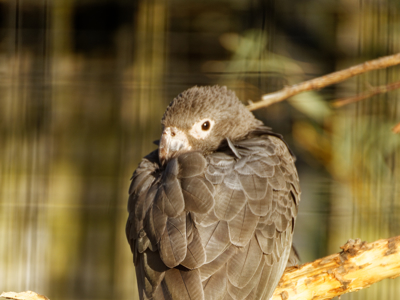
Vasa Parrot
Vasa parrots are members of the parrot family with a dark brown and grey plumage except for their bare heads where you can see pink-grey skin. Juveniles are more brown than grey and have a smaller bald area on their head.

Female vasa parrots are larger than the males. Unlike most parrots, where both male and female raise their chicks together, dominant vasa parrot females will mate with several different males. Each clutch will contain eggs fathered by at least two different males and during incubation the female will leave the nest to be fed by males she has previously mated with. The female defends her territory from other females with loud and complex songs.
The vasa parrot breeding season is between October and January. Baobab trees are particularly popular in West Madagascar and several nests may be built in the same tree at the same time. After hatching the chicks remain in the nest for between 45 and 49 days.

The diet of the vasa parrot is a mixture of fruit and seeds. They eat more seeds than their close relative, the lesser vasa parrot, and can eat maize on the stalk. Eating maize and rice means that they are regarded as a pest.
Vasa parrots are classified as Least Concern. Due to their pest status it is legal to hunt and kill them for food or to control numbers. However, the high level of hunting is causing population decline which could mean that the vasa parrot will become threatened in the future.
Key Facts:
Conservation Status: Least Concern
Distribution: Comoros, Madagascar
Habitat: Coniferous & Broadleaf Forests, Savannah, Scrublands, Tropical Forest
Diet: Fruit, Seeds
Height: 50cm
Weight: 400 – 550g
No. of young: 3
Life Span: 54 years

SUPPORT OUR ANIMALS
If you're looking for an alternative way to donate to Twycross Zoo, you can help support our animals and our zoo keepers by purchasing something from our Amazon Wishlist!
Updated regularly by our zoo keepers, the items on the list help to provide enrichment for our animals and keep their habitats well maintained.
Every donation helps us as a conservation charity.
